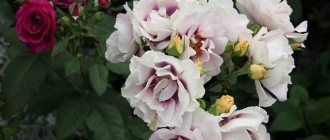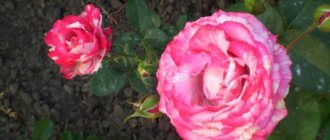The Prince of Monaco Jubilee rose stands out for its spectacular combined color, in which the delicacy of the white and cream petals is emphasized by a contrasting edging with rich raspberry and cherry shades. The compact bush is characterized by long, repeating flowering with an abundance of large fragrant flowers, collected in lush inflorescences. It is not surprising that experts and amateur gardeners around the world recognize the variety as one of the best representatives of the floribunda group.
Rose “Anniversary of the Prince of Monaco” (pictured) is a real aristocrat with refined shapes and exquisite colors
Main characteristics
The key features of the variety are presented in the table:
| Parameter | Characteristic |
| Culture | Rose (Rosa L.) |
| Variety | “Anniversary of the Prince of Monaco” (Jubile du Prince de Monaco, MEIsponge, Cherry Parfait, Fire & Ice, Jubile de Saint-Petersbourg) |
| Garden group | Floribunda (Fl.) / Floribunda (Fl.) |
| Form | Bush |
| Life cycle | perennial |
| Purpose | Decorative |
| Reproduction | Vegetative (by cuttings) |
| Bush height | 70-90 cm |
| Flowering type | Reblooming |
| Flowering period | June – September |
| Type of flower | Dense double |
| Number of petals | 35-40 pcs. |
| Flower diameter | 9-13 cm |
| Petal coloring | Two-color – white with crimson edging |
| Disease resistance | High |
| Frost resistance | Up to −25 ℃ |
| Registration in the State Register of the Russian Federation | Absent |
| Originator | Meilland (France) |
The advantages of floribunda include abundant and almost continuous flowering throughout the season.
Features of agricultural technology
It is surprising that with such outstanding decorative qualities, the Jubilee of the Prince of Monaco is distinguished by its unpretentiousness and ease of care, like all floribundas. It is winter-hardy and can withstand the winter of central Russia with a little shelter. In summer it is also not afraid of prolonged dry and hot periods, although on such days, of course, it is advisable to water the bushes and spray them regularly.
If this variety has any disadvantages, it is its relatively weak resistance to powdery mildew and black spot. However, modern drugs successfully cope with these problems, which you must not forget to treat your “Prince” in a timely manner.
A compact, profusely flowering rose bush is usually used in mixborders, in small groups. It should only be remembered that the flowering of the Prince of Monaco's Jubilee will be spectacular provided there is good lighting, as well as the absence of constant winds and drafts.
Origin
The variety was bred by specialists of the famous French rose-growing company (Meilland), registered as MEIsponge in 2000. The exhibition received its name in honor of the anniversary of the reigning Prince of Monaco. In catalogs in other countries, this rose is presented under different names. For example, in the USA it is called Cherry Parfait, in Australia it is called Fire & Ice. In Russia, the variety was demonstrated at an exhibition held during the celebration of the 300th anniversary of St. Petersburg, and was presented as Jubile de Saint-Petersbourg (“Anniversary of St. Petersburg”).
When creating the variety, breeders pollinated seedlings of the floribunda “Jacqueline Nebout / Meilland, 1989” with pollen of a hybrid obtained from crossing “Tamango” (Tamango / Meilland, 1965) and “Matangi” (Matangi / McGredy, New Zealand , 1974).
Floribundas "Jacqueline Nebu", "Tamango" (left) and "Matangi" (right) were used as parent forms.
The excellent qualities of the variety have been awarded with various awards at prestigious international exhibitions. The most prestigious of them: the Savern Rose Trials certificate (France) and the silver medal of the Madrid Rose Trials (Spain), received in 2000, the gold prize of the All-America Rose Selection Rose Trials (USA, 2003), the gold medal and title “Golden Floribunda” at the Australian National Rose Trials competition (Australia, 2004) and a gold medal at the Hills International Rose Trials (USA, 2006).
Pests
Mole crickets have appeared in the garden, this is very dangerous for your flowers, find out how to get rid of the pest
Medvedka
Several sources of foamy liquid have been observed on the rose bush; this is a dangerous pest.
Slobbering Penny
The rose will decorate the area if it is planted on the front side, next to the house or in the center of the lawn. If you make a rose garden from multi-colored roses, the Prince of Monaco will lose among the riot of colors; he looks more advantageous alone or next to plants of the same tone.
Description of the plant
A slender semi-spreading bush, reaching a height of 70-80 cm (up to 1 m), a width not exceeding 60 cm, remains compact and neat. The shoots develop actively and in the first season they can reach their maximum height, becoming woody in the lower part. They are covered with dull greenish bark with a moderate number of spines. The stems are straight and strong, easily supporting the weight of the flowers.
The foliage is quite dense and uniform from the base to the top of the bush. The foliage is dense, leathery, rich emerald green, semi-glossy. The leaf blade is large, ovoid in shape with a pronounced sharp tip and jagged edges, slightly concave in the center.
Bloom
The plant blooms almost continuously from the third decade of June until the last days of September, pauses between waves of flowering are hardly noticeable. The buds are collected in inflorescences-tassels, consisting of 3-5 pieces.
The bush does not lose its attractiveness throughout the season, as the flowers can easily withstand rain and scorching sun
A dense, medium-sized bud of white color with a slight greenish tint only along the edge of the petals has a narrow reddish edging, which expands as it dissolves and acquires a more saturated raspberry-cherry color. The flower opens slowly, hiding the stamens until flowering, and stays on the bush for about two weeks.
A double, consisting of 35-40 petals, an ideal cup-shaped flower at the stage of full dissolution reaches 8-13 cm in diameter. The petal is large, velvety, dense at the base and thins towards the wavy, outward-bending edges.
The variety has a pleasant, not strong aroma, which contains light fruity and subtle tea notes.
The “Anniversary of the Prince of Monaco” rose performed well as a cut flower – in a vase with water, the flowers remain fresh for 7 days.
In the original gradient color, the bright white color gradually gives way to a soft cream color, and the red edging from the edge of the petal expands, acquiring a cherry hue
Trimming
Time: spring. But before starting the process, it is necessary to determine its goal - the formation of a bush or the achievement of abundant flowering. Depending on this, the following types are distinguished:
- Strong (short). It is carried out to rejuvenate aged bushes and after planting new seedlings. Leave 2-4 buds on each shoot.
- Average. Necessary for early formation and blooming of buds, it adds decorativeness to the stem. The recommended number of buds is 5-7 pieces.
- Weak. It is used in the summer, when the tops of shoots that have already bloomed are removed.
With the arrival of spring, the stem is inspected and parts that have succumbed to frostbite are cut off.
Pruning floribunda roses: video
The buds on the bushes of the first year must be cut off before August. Later leave 1-2 flowers on the shoot. This manipulation will ensure better wintering and abundance in the coming season.
Related article:
How to quickly and surely destroy roses in the garden
In autumn, manipulation is considered a sanitary measure when damaged shoots are cut off.
Specifics of cultivation and agrotechnical recommendations
The variety is characterized by low maintenance, hardiness, disease resistance and frost resistance. Light-loving rose prefers fertile soils with a neutral or slightly acidic reaction and good aeration in open or semi-shaded areas, protected from drafts and with a groundwater level not exceeding 1.5 m.
The variety has average resistance to frost and fungal diseases. Caring for the plant consists of regular abundant watering, fertilizing 3-6 times during the season, preventive treatments against diseases and pests, sanitary and formative pruning. By winter, it is recommended to hill up the bushes by 20-25 cm and cover them with 3-4 layers of non-woven material.
Landscape designers recommend planting “Prince of Monaco” as a tapeworm or in groups of 2-4 bushes. Two-color roses look impressive against the background of coniferous plants, in flower beds in combination with plain white or red flowers.
The variety is used in garden and park design, grown in pots and standard crops
You can learn about the varieties “Midsummer”, “Geisha” and “Bella Rosa”, which belong to the Floribunda garden group, from the articles on our website.
Features of planting and care
Grapes Jubilee Novocherkassk
You should not buy young seedlings at spontaneous markets: as practice shows, an inexperienced gardener has a high risk of purchasing some wild bush instead of the treasured roses. When choosing seedlings, it is important to pay attention to their appearance, leaves and roots. The stems deserve special attention - only one of them should have a “non-living” appearance, the rest should be green, fresh and healthy.
Additional Information! Experienced experts advise beginners to buy seedlings that are no more than three years old, since young plants take root best in a new place and are easier to tolerate unfavorable climatic conditions.
Proper planting is the key to the prosperity and longevity of flowers. Despite the variety's resistance to various unfavorable factors, it is necessary to choose the right planting site - the Prince of Monaco, like all other roses, is very picky about this aspect. This variety loves the sun and warmth very much, so it should be planted in an unshaded place, but if the owner lives in hot, arid latitudes, he will have to organize full watering, otherwise the bush will simply dry out.
The Prince de Monaco variety does not tolerate drafts, so the rose should be planted in a place protected from the winds. If this condition is not met, the flowers will fly away very quickly.
Important! Under no circumstances should you plant a bush where other roses once grew, otherwise pests and parasites living in the soil will destroy the new plant if 6-7 years have not passed since the removal of the previous flowers.
The soil should be rich in nitrogen and nutrients. To improve the germination of a new bush, it is recommended to dilute mullein 1 to 10 or bird droppings in the same proportion. In addition, the Prince of Monaco does not like a lot of moisture, so where there is groundwater or marshy soil, it will not grow. Typically, such problems do not arise for summer residents, since many prefer to plant roses in flower beds or outside the yard, where the soil is dry and dense - and this is absolutely correct.
Rose of Monaco
Roses do not require special care - you just need to care for them in the same way as other varieties. However, it is important to water them regularly, but this should be done early in the morning or in the evening, when the sun has already set - this will avoid serious burns to the plant. You need to pour water directly at the root - the plant really doesn’t like it when leaves or stems are watered, and it will also be an excellent breeding ground for fungi and pests. The plant should also not be over-watered, since prolonged watering will cause the roots to rot, which will lead to the death of the rose. An ideal option would be a drip irrigation system, which will provide a sufficient amount of moisture and will not harm the plant.
Reviews from gardeners
Irina, 56 years old, Yaroslavl
In the shade, my Prince bloomed with rather small and almost red flowers. After transplanting to a sunny area, it quickly grew stronger, the flowers became larger and lighter, and it blooms continuously. The flower lasts a long time. It winters well, but you shouldn’t bend it to the ground; it’s better to tie the shoots together and wrap them with covering material.
Anna, 41 years old, Rostov region
The bush grows in full sun, blooms very intensely in the first wave, and much more modestly in the second. Produces few basal shoots. The rose looks perfect only at the stage of half-blooming, then it turns into blurry crimson semi-double saucers with a bare center, the petals quickly turn red, appear in spots with some kind of dirty tint. It gives me a feeling of sloppiness. I'll probably get rid of it.
Tamara, 60 years old, Mozhaisk
I bought a seedling from a friend from a rooted cutting 5 years ago. At first he was weak, but he survived and gradually grew stronger. Over the course of a year, it grew into a low bush of 3 branches, crooked and lopsided. Of course, it blooms beautifully. It starts one of the first, around the 10th of June. The waves are stable, with an interval of about a month. The flowers are white with a creamy tint and a pink-crimson border, which gradually “fills” the petals, expanding depending on the weather. The buds are collected in small clusters, the number of simultaneously blooming flowers increases from year to year. With high humidity, black spot easily picks up.
Pros and cons of the variety
Advantages:
- Unusual, beautiful colors of buds, which change three times per season;
- Long flowering throughout the summer season until early September;
- All summer the bush performs a decorative function and does not become an empty cutting;
- Tolerates frost and cold well;
- Tolerates rainy weather well;
- The variety fits well into any landscape design and decorates personal plots, gardens, parks and public gardens.
Flaws:
- Rose does not like high humidity;
- With high humidity, there are significantly fewer flowers.
Recommendations for caring for flowers
In order for the plant to develop normally and bloom luxuriantly, it is worth providing it with good care.
Watering and fertilizers
It is recommended to water the plant every 2 weeks. In hot and dry weather, this should be done every 3 days. It is recommended to pour water carefully, without touching the leaves and flowers. For 1 bush you will need 1 bucket of water.
Excess liquid has a negative impact on the condition of the crop.
In the first year of plant life, it is fed with organic means. An infusion of ash, liquid mullein, or a solution of bird droppings are suitable for this. Ready-made formulations - Planta or Baikal-EM - are also suitable.
See also
How to treat roses against rust, folk remedies and chemicalsRead
It is recommended to apply fertilizer immediately after watering. Otherwise, there is a high probability of damage to the root system. From the age of 2 years, it is worth fertilizing the crop 6-7 times a season. It is recommended to alternate organic matter with mineral compounds. For this purpose, use Nitrophoska or superphosphate.
Trimming
It is recommended to prune roses twice a year - in spring and autumn. In the second case, the procedure is performed in mid-October. It is recommended to remove all green fragments of branches. Thanks to this, the strongest shoots will remain. They should be cleared of leaves.
In the spring, after removing the insulating layer, it is recommended to conduct a detailed inspection of the bushes and remove broken and frostbitten branches. After this, the strongest shoots should remain.
Preparing for winter
The variety is considered frost-resistant. It can withstand temperatures down to -25 degrees. However, in regions with an unfavorable climate, the plant should be covered. After pruning, the soil near the bushes is covered with a mulch layer and covered with dry leaves. It is recommended to cover it with spruce branches or special material on top.
Disease and pest control
This variety is characterized by average resistance to diseases and parasites. If climatic conditions are poor or agricultural practices are violated, there is a risk of crop contamination. Most often, roses encounter the following pathologies:
- rust;
- black spot;
- powdery rose.
To cope with diseases, it is worth getting rid of the affected fragments and treating the bushes with fungicides 2 times.
Of the pests, the crop is more susceptible to the following insects:
- cicada;
- aphid;
- bronze;
- sawfly.
To cope with parasites, the crop is treated with insecticidal preparations. They are sold in specialized stores.
Bloom
Watching this rose bloom is a real pleasure! At first, the buds of the rose are light and medium in size , but the edges of each petal have a reddish tint. As the bud blooms, the brightness and saturation of the border increases.
The opened flower has a diameter of 10 cm with a number of petals of up to 30-40 pieces, and the height of the bush is 70-80 cm. Fresh petals are initially white-cream, with the already mentioned crimson border. As it grows, the cream color turns into a light cherry color. At the height of flowering, the roses resemble a whitish-crimson cloud.
The flowering of this plant is intense, because dozens of flowers appear on the shoots at one time!











